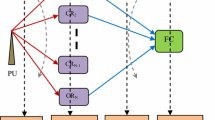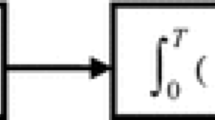Abstract
An appropriate threshold selection scheme is one of the main components to adjudicate the performance of energy detection spectrum sensing (EDSS) technique for cognitive radio network. In this paper, we have employed two different threshold selection approaches namely, the constant false-alarm rate (CFAR) and minimized error probability (MEP) and analyzed the threshold selection effects on the performance of cognitive user (CU) communication systems particularly, the total spectrum sensing error probability and throughput. We have derived the expressions and analyzed these performance parameters by considering an imperfect spectrum sensing and reporting channels in the cooperative spectrum sensing scenarios for additive white Gaussian noise (AWGN), Rayleigh and Nakagami-m fading environments. In addition, the censoring concept has been applied to the proposed system and compared its effect with that of the non-censoring based cognitive radio network (CRN) system under the perfect reporting (PR) and imperfect reporting (IR) channel. With the help of simulation, we have illustrated that the role of threshold selection approach is crucial to maximize the throughput and minimize the spectrum sensing error while considering the amount of error in the reporting channel. Further, from the results, the existence of trade-off between the spectrum sensing error probability and throughput is presented with threshold selection approaches. Moreover, it is also shown that there is need to switch among CFAR and MEP threshold selection approaches in the censoring scenario, to enhance the throughput and decrease the spectrum sensing error probability.









Similar content being viewed by others
References
Zhang, R. (2009). On peak versus average interference power constraints for protecting primary users in cognitive radio networks. IEEE Transaction on Wireless Communication, 8(4), 2112–2120.
Pandit, S., & Singh, G. (2017). Spectrum sharing in cognitive radio networks: Medium access control protocol based approach. Switzerland: Springer.
Thakur, P., Singh, G., & Satashia, S. N. (2016). Spectrum sharing in cognitive radio communication system using power constraints: A technical review. Perspectives in Science, 8, 651–653.
Parsons, S (2014). Literature review of cognitive radio spectrum sensing. EE 359 Project, California: Stanford University.
Ali, A., & Hamouda, W. (2017). Advances on spectrum sensing for cognitive radio networks: Theory and applications. IEEE Communication Surveys Tutorial, 19(2), 1277–1304.
Guo, C., Jin, M., Guo, Q., & Li, Y. (2019). Anti-eigen value-based spectrum sensing for cognitive radio. IEEE Wireless Communication Letter, 8(2), 544–547.
Urkowitz, H. (1967). Energy detection of unknown deterministic signals. Proceeding of the IEEE, 55(4), 523–531.
Nafkha, A., & Aziz, B. (2014). Closed-form approximation for the performance of finite sample-based energy detection using correlated receiving antennas. IEEE Wireless Communications Letters, 3(6), 577–580.
Atapattu, S., Tellambura, C., & Jiang, H. (2010). Analysis of area under the ROC curve of energy detection. IEEE Transactions on Communications, 9(3), 1216–1225.
Atapattu, S., Tellambura, C., Jiang, H., & Rajatheva, N. (2015). Unified analysis of low-SNR energy detection and threshold selection. IEEE Transactions on Vehicular Technology, 64(11), 5006–5019.
Yang, X., Lei, K., Peng, S., Hu, L., Li, S., & Cao, X. (2019). Threshold setting for multiple primary user spectrum sensing via spherical detector. IEEE Wireless Communication Letter, 8(2), 488–491.
Verma, G., & Sahu, O. P. (2016). Opportunistic selection of threshold in cognitive radio networks. Wireless Personal Communication, 92(2), 711–726.
Atapattu, S., Tellambura, C., and Jiang, H. (2011).Spectrum sensing via energy detector in low SNR. Proceedings IEEE International Conference on Communications (ICC), Kyoto, Japan (pp.1–5).
Liang, Y. C., Zeng, Y., Peh, E., & Hoang, A. T. (2008). Sensing-throughput tradeoff for cognitive radio networks. IEEE Transaction on Wireless Communication, 7(4), 1326–1337.
Renzo, M. D., Imbriglio, L., Graziosi, F., & Santucci, F. (2009). Distributed data fusion over correlated log-normal sensing and reporting channels: Application to cognitive radio networks. IEEE Transaction on Wireless Communication, 8(12), 5813–5821.
Adelantado, F., Juan, A., & Verikoukis, C. (2010). Adaptive sensing user selection mechanism in cognitive wireless networks. IEEE Communication Letters, 14(9), 800–802.
Nallagonda, S., Chandra, A., Roy, S. D., Kundu, S., Kukolev, P., & Prokes, A. (2016). Detection performance of cooperative spectrum sensing with hard decision fusion in fading channels. International Journal of Electronics, 103(2), 297–321.
Akyildiz, I. F., Lo, B. F., & Balakrishnan, R. (2011). Cooperative spectrum sensing in cognitive radio networks: A survey. Physical Communication, 4(1), 40–62.
Sun, C., Zhang, W. and Ben, L. K. (2007). Cooperative spectrum sensing for cognitive radios under bandwidth constraints. Proceeding of IEEE Wireless Communications and Networking Conference, Kowloon (pp. 1–5).
Choi, Y. J., Park, W., Xin, Y., & Rangarajan, S. (2012). Throughput analysis of cooperative spectrum sensing in Rayleigh-faded cognitive radio systems. IET Communication, 6(9), 1104–1110.
Nallagonda, S., Roy, S. D., Kundu, S., Ferrari, G., & Raheli, R. (2018). Censoring-based cooperative spectrum sensing with improved energy detectors and multiple antennas in fading channels. IEEE Transactions on Aerospace and Electronic Systems, 54(2), 537–553.
Li, M., Alhussein, O., Sofotasios, P. C., Muhaidat, S., Yoo, P. D., Liang, J., & Wang, A. (2019). Censor-based cooperative multi-antenna spectrum sensing with imperfect reporting channels. IEEE Transactions on Sustainable Computing, 5(1), 48–60.
Koley, S., Mirza, V., Islam, S., & Mitra, D. (2015). Gradient-based real-time spectrum sensing at low SNR. IEEE Communication Letter, 19(3), 391–394.
Zhang, W., Mallik, R. K., & Letaief, K. B. (2009). Optimization of cooperative spectrum sensing with energy detection in cognitive radio networks. IEEE Transactions on Wireless Communication, 8(12), 5761–5766.
Kumar, A., Thakur, P., Pandit, S., & Singh, G. (2019). Analysis of optimal threshold selection for spectrum sensing in a cognitive radio network: An energy detection approach. Wireless Network, 25(7), 391–3931.
Kumar, A., Thakur, P., Pandit, S., & Singh, G. (2020). Intelligent threshold selection in fading environment of cognitive radio network: Advances in throughput and total error probability. International Journal of Communication Systems, 33(1), e4175.
Peh, E. C. Y., Liang, Y. C., Guan, Y. L., & Zeng, Y. (2009). Optimization of cooperative sensing in cognitive radio networks: A sensing-throughput tradeoff view. IEEE Transactions on Vehicular Technology, 58(9), 5294–5299.
Liu, X., & Tan, X. (2012). Optimization algorithm of periodical cooperative spectrum sensing in cognitive radio. International Journal of Communication Systems, 27(5), 1–16.
Tuan, P. V., & Koo, I. (2016). Throughput maximization by optimizing detection thresholds in full-duplex cognitive radio networks. IET Communications, 10(11), 1355–1364.
Lu, Y., Wang, D., & Fattouche, M. (2016). Cooperative spectrum-sensing algorithm in cognitive radio by simultaneous sensing and BER measurements. EURASIP Journal on Wireless Communications and Networking, 136, 1–22.
Li, H., & Liu, C. (2018). Cross-layer optimization for full-duplex cognitive radio network with cooperative spectrum sensing. International Journal of Communication Systems, 32(5), 1–33.
Fan, R., & Jiang, H. (2010). Optimal multi-channel cooperative sensing in cognitive radio networks. IEEE Transactions on Wireless Communications., 9(3), 1128–1138.
Tang, W., Shakir, M. Z., Imran, M. A., Tafazolli, R., & Alouini, M. S. (2012). Throughput analysis for cognitive radio networks with multiple primary users and imperfect spectrum sensing. IET Communications, 6(17), 2787–2795.
Yadav, K., Prasad, B., Bhowmick, A., Roy, S. D., & Kundu, S. (2017). Throughput performance under primary user emulation attack in cognitive radio networks. International Journal of Communication Systems, 30(18), 1–9.
Sharifi, M., Sharifi, A. A., & Niya, M. J. M. (2018). Cooperative spectrum sensing in the presence of primary user emulation attack in cognitive radio network: Multi-level hypotheses test approach. Wireless Network, 24(1), 61–68.
Althunibat, S., Renzo, M. D., and Granelli, F. (2013). Optimizing the K-out-of-N rule for cooperative spectrum sensing in cognitive radio networks. Proceeding of IEEE Global Communications Conference (GLOBECOM), Atlanta (pp. 1607–1611).
Althunibat, S., Renzo, M. D., & Granelli, F. (2015). Towards energy-efficient cooperative spectrum sensing for cognitive radio networks: An overview. Telecommunication Systems, 59(1), 77–91.
Hu, H., Zhang, H., & Liang, Y. C. (2016). On the spectrum-and energy-efficiency tradeoff in cognitive radio networks. IEEE Transactions on Communications, 64(2), 490–501.
Bhowmick, A., Roy, S. D., & Kundu, S. (2015). Sensing throughput trade-off for an energy efficient cognitive radio network under faded sensing and reporting channel. International Journal of Communication Systems, 29(7), 1208–1218.
Najimi, M. (2018). Sensing time optimization and sensor selection in multi-channel multi-antenna wireless cognitive sensor networks. IET Communications, 12(6), 795–801.
Zhao, N., Pu, F., Xu, X., & Chen, N. (2013). Optimization of multi-channel cooperative sensing in cognitive radio networks. IET Communications, 7(12), 1177–1190.
Gahane, L., & Sharma, P. K. (2017). Performance of improved energy detector with cognitive radio mobility and imperfect channel state information. IET Communications, 11(12), 1857–1863.
Firouzabadi, A. D., & Rabiei, A. M. (2015). Sensing-throughput optimization for multichannel cooperative spectrum sensing with imperfect reporting channels. IET Communications, 9(18), 2188–2196.
Chaudhari, S., Lundén, J., Koivunen, V., & Poor, H. V. (2012). Cooperative sensing with imperfect reporting channels: Hard decisions or soft decisions? IEEE Transactions on Signal Processing, 60(1), 18–28.
Sakran, H., & Shokair, M. (2013). Hard and softened combination for cooperative spectrum sensing over imperfect channels in cognitive radio networks. Telecommunication System, 52(1), 61–71.
Yilmaz, H. B., Tugcu, T., & Alagoz, F. (2014). Novel quantization-based spectrum sensing scheme under imperfect reporting channel and false reports. International Journal of Communication Systems, 27(10), 1459–1475.
Mi, Y., Lu, G., Li, Y., & Bao, Z. (2019). A novel semi-soft decision scheme for cooperative spectrum sensing in cognitive radio networks. Sensors Networks, 19(11), 1–12.
Bae, S., & Kim, H. (2016). Robust cooperative sensing with ON/OFF signaling over imperfect reporting channels. IEEE Transactions on Industrial Informatics, 12(6), 2196–2205.
Liu, X., Zhang, X., Ding, H., & Peng, B. (2019). Intelligent clustering cooperative spectrum sensing based on Bayesian learning for cognitive radio network. Ad Hoc Networks, 94, 101968.
Oh, D. C., & Lee, Y. H. (2010). Cooperative spectrum sensing with imperfect feedback channel in the cognitive radio systems. International Journal of Communication Systems, 23, 763–779.
Ghorbel, M. B., Nam, H., & Alouini, M. S. (2015). Soft cooperative spectrum sensing performance under imperfect and non-identical reporting channels. IEEE Communications Letters, 19(2), 227–230.
Li, M., Wang, A., & Pan, J. S. (2016). Cognitive Wireless Networks Using the CSS Technology. Cham: Springer.
Jiang, R., & Chen, B. (2005). Fusion of censored decisions in wireless sensor networks. IEEE Transaction on Wireless Communication, 4(6), 2668–2673.
Atmaca, S., Sayli, O., Yuan, J., & Kavak, A. (2017). Throughput maximization of CSMA in cognitive radio networks with cooperative spectrum sensing. Wireless Personal Communications, 92(4), 1473–1492.
Liu, X., Zhong, W. Z., & Chen, K. Q. (2015). Optimization of sensing time and cooperative user allocation for OR-rule cooperative spectrum sensing in cognitive radio network. Journal of Central South University, 22(7), 2646–2654.
Juarez, M. C., & Ghogho, M. (2011). Spectrum sensing and throughput trade-off in cognitive radio under outage constraints over Nakagami fading. IEEE Communications Letters, 15(10), 1110–1113.
Rabiee, R., and Li, K. H. (2013). Throughput optimization of double-threshold based improved energy detection in cooperative sensing over imperfect reporting channels. In 2013 Proceeding of 9th International Conference on Information, Communication and Signal Processing, Tainan, (pp. 1–5).
RabieeLi, R. K. H. (2015). Performance evaluation of improved double-threshold energy detector over Rayleigh-faded sensing and imperfect reporting channels. Physical Communication, 17, 58–71.
Charan, C., & Pandey, R. (2018). Intelligent selection of threshold in covariance based spectrum sensing for cognitive radio networks. Wireless Network, 24(8), 3267–3279.
Banavathu, N. R., & Khan, M. Z. A. (2019). Optimization of k-out-of-N rule for heterogeneous cognitive radio networks. IEEE Signal Processing. Letter, 26(3), 445–449.
Isukapalli, Y., & Rao, B. D. (2008). An analytically tractable approximation for the Gaussian Q-function. IEEE Communications Letters, 12(9), 669–671.
Acknowledgements
The authors are sincerely thankful to the anonymous reviewers for their critical comments and suggestions to improve the quality of the manuscript.
Author information
Authors and Affiliations
Corresponding author
Additional information
Publisher's Note
Springer Nature remains neutral with regard to jurisdictional claims in published maps and institutional affiliations.
Rights and permissions
About this article
Cite this article
Kumar, A., Pandit, S. & Singh, G. Threshold selection analysis of spectrum sensing for cognitive radio network with censoring based imperfect reporting channels. Wireless Netw 27, 961–980 (2021). https://doi.org/10.1007/s11276-020-02488-9
Accepted:
Published:
Issue Date:
DOI: https://doi.org/10.1007/s11276-020-02488-9




